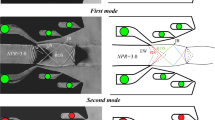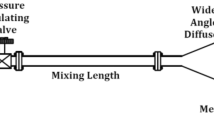Abstract
Techniques using Coanda effect have been applied to the fluid control devices. In this field, experimental studies were so far performed for the spiral jet obtained by the Coanda jet issuing from a conical cylinder with an annular slit, thrust vectoring of supersonic Coanda jets and so on. It is important from the viewpoints of effective applications to investigate the characteristics of the supersonic Coanda jet in detail. In the present study, the effects of pressure ratios and nozzle configurations on the characteristics of the supersonic Coanda jet have been investigated experimentally by a schlieren optical method and pressure measurements. Furthermore, Navier-Stokes equations were solved numerically using a 2nd-order TVD finite-volume scheme with a 3rd-order three stage Runge-Kutta method for time integration. k - ε model was used in the computations. The effects of initial conditions on Coanda flow were investigated numerically. As a result, the simulated flow fields were compared with experimental data in good agreement qualitatively.
Similar content being viewed by others
References
Seaton, C.E., Henein, H. and Glatz, M., “Atomization of Molten Metals Using the Coanda Effect,” Powder Metallurgy, 30, No.1, pp.37–47, (1987).
Acar, M., Turton, R.K. and Wray, G.R., “Air Flow in Yarn Texturing Nozzles,” Transactions of the ASME, Journal of Engineering for Industry, 109, pp.197–202, (1987).
Demir, A., “A Study of Air-Jet Texturing Nozzles: The Effects of Nozzle Configuration on the Air Flow,” Transactions of the ASME, Journal of Engineering for Industry, 112, pp.97–104., (1990).
Horii, K., Matsumae, Y., Cheng, X.M., Takei, M. and Hashimoto, B., “A Study of Spiral Flow (Part 3) Opening and Orientation Control of Fiber by Spiral Flow,” Trans. Jpn. Soc. Aero Space Sci., 32, No.98, pp.155–164, (1990).
Horii, K., Matsumae, Y., Cheng, X.M., Takei, M. and Hashimoto, B., “A Study of Spiral Flow (Part 4) The Effect of Radial Reynolds Number of Spiral Flow,” Trans. Jpn. Soc. Aero Space Sci., 32, No.98, pp.165–175, (1990).
Horii, K., Matsumae, Y., Cheng, X.M., Takei, M. and Hashimoto, B., “A Study of Spiral Flow (Part 5) Analysis of Frictional Force Acting on Short Fiber,” Trans. Jpn. Soc. Aero Space Sci., 32, No.98, pp.1178–183, (1990).
Horii, K., Matsumae, Y., Ohsumi, K., Cheng, X.M., Kage, S. and Hashimoto, B., Novel Optical Fiber Installation by Use of Spiral Airflow,” Transactions of the ASME, Journal of Fluids Engineering, 114, pp.375–378, (1992).
Horii, K., Matsumae, Y., Cheng, X.M., Takei, M. and Yasukawa, E., “Focusing Phenomenon and Stability of Spiral-Flow Jet,” Trans. Jpn. Soc. Aero Space Sci., 133, No.102, pp.141–153, (1991).
Shrewsbury, G.D., “Numerical Study of a Research Circulation Control Airfoil Using Navier-Stokes Methods,” Journal of Aircraft, 26, No.1, pp.29–34, (1989).
Linton, S.W., “Computation of the Poststall Behavior of a Circulation Controlled Airfoil,” Journal of Aircraft, 31, No.6, pp.1273–1280, (1994).
Williams, S.L. and Franke, M. E., “Navier-Stokes Methods to Predict Circulation Control Airfoil Performance,” Journal of Aircraft, 29, No.2, pp.243–249, (1992).
Cornelius, K.C. and Lucius, G.A., “Physics of Coanda Jet Detachment at High-Pressure Ratio,” Journal of Aircraft, 31, No.3, pp.591–596, (1994).
Gregory-Smith, D.G. and Gilchrist, A.R., “The Compressible Coanda Wall Jet, an Experimental Study of Jet Structure and Breakaway,” Journal of Heat and Fluid Flow, 8, pp.156–164, (1987).
Asami, K. and Sawada, K., “Numerical Study on Underexpanded Coanda Jet,” AIAA 96-1936, (1996-6).
Sawada, K. and Asami, K., “Numerical Study on Underexpanded Coanda Jet,” Journal of Aircraft, 34, No.5, pp.641–647, (1997).
Bevilaqua, Paul M. and Lee, John D., “Design of Supersonic Coanda Jet Nozzles,” AIAA 84-0333, (1984-1).
Wilkins, J., Witheridge, R.E., Densty, D.H., Mason, J.T.M. and Newby, N., “The Design, Development and Performance of Indair and Mardair Flares,” Offshore Technology Conference, 2822, pp.123–130, (1977-10).
Desty, D.H., “No Smoke with Fire,” Proc Instn Mech Engrs, 197A, pp.159–170, (1983-2).
Carpenter, P.W., “The Aeroacoustics and Aerodynamics of High-speed Coanda Devices,” The Seventh Asian Congress of Fluid Mechanics, 8, No.12, pp.199–202, (1997).
Carpenter, P.W. and Bridson, D.W., “Features of Discrete Tones Generated by Jet Flows Over Coanda Surfaces,” AIAA 10th Aeroacoustics Conference, 86-1865, (1986-7).
Carpenter, P.W. and Green, P.N., “The Aeroacoustics and Aerodynamics of Hight-speed Coanda Devices: Part 1. Conventional Arrangement of Exit Nozzle and Surface,” Journal of Sound and Vibration, 208, No.5, pp.777–801, (1997).
Carpenter, P.W. and Smith, C., “The Aeroacoustics and Aerodynamics of High-speed Coanda Devices: Part 2. Effect of Modifications for Flow Control and Noise Reduction,” Journal of Sound and Vibration, 208, No.5, pp.803–822, (1997).
Tulapurkara, E.G., “Turbulence Models for the Computation of Flow Past Airplanes,” Prog.Aerospace Sci., 33, pp.71–165, (1997).
Lin, H. and Chieng, C-C., “Comparisons of TVD Schemes for Turbulent Transonic Projectile Aerodynamics Computations with a Two-Equation Model of Turbulence,” International Journal for Numerical Methods in Fluids, 16, pp.365–390, (1993).
Chien, K-Y., “Predictions of Channel and Boundary-Layer Flows with a Low-Reynolds-Number Turbulence Model,” AIAA Journal, 20, pp.33–38, (1982).
Yee, H.C., “A Class of High-Resolution Explicit and Implicit Shock-Capturing Methods,” NASA TM 101088 (1989-2).
Hirsch, C., “Numerical Computation of Internal and External Flows,” 2, A Wiley-Interscience Publication, (1988).
Pulliam, T.H. and Chaussee, D.S., “A Diagonal Form of an Implicit Approximate-Factorization Algorithm,” J. Comp. Phys., 39, pp.347–363, (1981).
Hirsch, C., “Numerical Computation of Internal and External Flows,” 1, A Wiley-Interscience Publication, (1988).
Fujii, K., «Numerical Methods for Computational Fluid Dynamics», University of Tokyo Press, (in Japanese), (1994).
Wada, Y., Ogawa, S. and Arai, N., “A Numerical Calculation of Hypersonic Flow Around Blunt Bodies Using Upwind Difference Scheme,” National Aerospace Laboratory, (in Japanese), TR-1025 (1989-7).
Author information
Authors and Affiliations
Rights and permissions
About this article
Cite this article
Matsuo, S., Setoguchi, T., Kudo, T. et al. Study on the characteristics of supersonic Coanda jet. J. of Therm. Sci. 7, 165–175 (1998). https://doi.org/10.1007/s11630-998-0012-2
Issue Date:
DOI: https://doi.org/10.1007/s11630-998-0012-2




